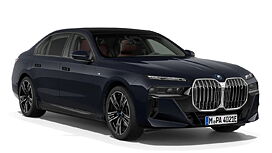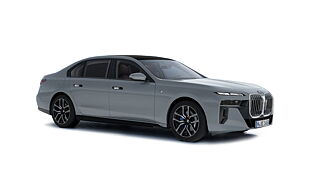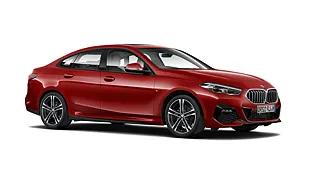Why would I buy it?
- It’s a tech fest
- Easy to drive with phenomenal ride
- Lighting performance for its size
Why would I avoid it?
- Some interior trims don’t belong in i7
- Polarising design
- Not conventional luxury
What is it?

When I walked up to the i7, it felt like the scene from Tomorrow Never Dies (the first Bond movie I watched in 1997) when Q introduced Pierce Brosnan to the BMW 750Li. Of course, instead of the machine guns and rockets, this one packs a much more sophisticated system, three decades after Mr Bond drove a BMW all over the parking lot. For those still uninitiated, the i7 is the electric equivalent of the eighth-generation 7 Series.

It wouldn’t be wrong to point out that the new i7 wears a silhouette of a Rolls Royce. With its long bonnet, upright stance, sleek headlamps with LED crystals, and massive 21-inch wheels, the i7 appears to glide along silently in an effortless motion, even when standing still.

I was sceptical about the enlarged kidney grille at first, but it fits right with the imposing character of the i7 as a Cartier necklace would adorn a queen’s neck, especially when illuminated. However, the indistinctive flush door handles look cheap and out of place. And the rear appears like an insipid line drawing, if not for those sleek taillamps.

Overall, the i7 isn’t as obnoxious-looking as I initially thought. Instead, it carves a fine line between traditional luxury and tech-savvy new money.
Is the cabin of the BMW i7 any good?

Since tech-savvy buyers aren’t used to opening the doors themselves anymore, the i7 does it for them. All four doors can be opened automatically and they are intelligent too. So, if there’s an obstacle in their path, they will unlock but won’t open – one of the many tech-fest features of the i7 – and we haven’t even been inside it yet!

So get in and the dashboard looks like any other BMW. Sure, the curved screen is new, but you now get it across all the new-generation BMWs. And even the OS8 it comes with is seen in other models. But you get glass-crystal-cut elements all over, which look and feel rich and classy.

Then, the i7 gets ‘modes’, and not just drive modes. These modes transform the entire personality of the cabin. For instance, if you select the Theatre mode, it shuts the blinds, slides the massively wide 32-inch screen down from the roof, reclines the seats, and teleports you to your own Netflix and Chill on the move. Similarly, the Relax mode will put on soothing ambient lighting and turn on the massage function and calming music. Similarly, there are the Expressive, Art, Efficient, Personal, and Sports modes.

As in any opulent luxo-barge, the front seats are large and comfortable and come with heated/cooling/massage functions. But it’s the second row where all the fun is. Passengers here get their own smartphone-sized screens integrated into the door pads which control all the functions of the car and more. So apart from the vehicle mood, the start-up CEO, director, or the business baron sitting at the back can control the massage options, blinds, and the theatre screen and even engage the full-fledged recliner seats at the touch of a button.

Further, pretty much everything can be voice controlled. This is helpful since the OS8 interface running on the screen is a bit tricky and too complicated to operate. We like how there’s an augmented reality display on the MID, which projects a front camera and real-time direction overlaid on it, making it look straight out of a sci-fi movie.

There’s also advanced driver assist hardware, but the funkiest bit is where the i7 can trace a few metres in reverse, controlling the steering. You can also save a certain path, and when activated, it will follow it to the T – really helpful when parking in tight spaces.

If we were to nitpick, some elements inside the cabin are shared with much more affordable BMWs. The tactile-less black buttons on the centre console for example. Overall, the cabin of the i7 might not feel conventionally luxurious, but it feels experimentally futuristic, exuding grandiose characteristics.
Is the BMW i7 good to drive?

As majestically Rolls Royce-y as it looks, the i7 also moves with the same demeanour. It’s silent – not only because of its electric nature – but it’s so well-insulated. And boy, can the i7 – for its size and stature – move. Pull the paddle shifter (yes, there’s only one shifter on the left of the steering), and you get a 10-second boost mode where all of its 544 horses are unshackled. And you can easily describe how it must feel when hurled off a catapult.

With no exaggeration, the i7’s claimed acceleration is quick – 0-100kmph in 4.7 seconds. For reference, that’s as quick as the 996 Porsche GT3 and the V12 Aston Martin DB9. But these were supercars of their time, and the i7 is more of a land whale in comparison. Admittedly, the i7 is a huge and heavy car, yet the way it flings towards the horizon appears like it’s rewriting the laws of physics.

But it’s only when the accelerator is stomped hard on occasions when the mogul or new-age tycoon wants to have fun. For those who are driven in the backseat, the i7 will pamper the said magnate in as much comfort and pampering as any traditional luxo-barge.

Since the air suspension on the i7 has been tuned brilliantly, it manages to take in all road imperfections with finesse. Even the large, 21-inch wheels wrapped with 35-section tyres don’t deter the fantastic ride quality that the i7 offers. You can also raise the ride height to tackle the speed breakers, but it is surprising that within a week of driving the i7, never once did it scrape on any speed breaker. But the i7 did give me a habitual bottom clenching in every other car each time I approached a speed breaker.

Then, the all-wheel steering in itself is quick and direct. And the rear-wheel steering is phenomenal in its own right. Spanning 5.4m in length, the i7 is a long car, but the rear steering makes manoeuvring it in the city as easy as piloting, say a Honda City. When you have to take a U-turn, the i7 simply wraps around you with phenomenal dexterity.
Should you buy the BMW i7?

Unlike the EQS, the i7 comes as a CBU in India and is available in one trim costing Rs. 2.08 crore (OTR Mumbai). Surprisingly, the i7 doesn’t demand a huge premium over the petrol-derivative 7 Series. While traditional luxury seekers might prefer the trusted Three-Pointed EQS, the i7 would fascinate those new self-made millionaires.

The i7 is a tech-fest, but some elements in it don’t belong in a luxo-barge costing over two crore rupees. But that’s how BMW likes to play the game. And if James Bond wasn’t too busy with his escapades in Aston Martins of late, I bet he wouldn’t mind taking his next assignment in the i7.
Pictures by Kapil Angane

































